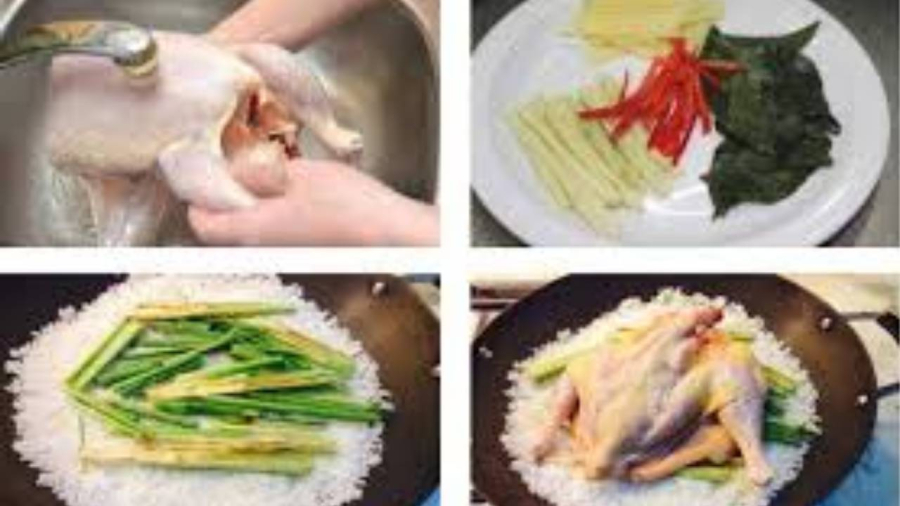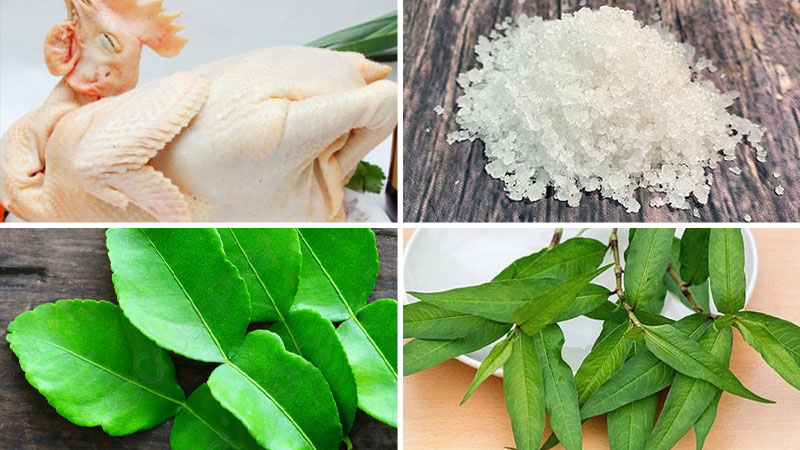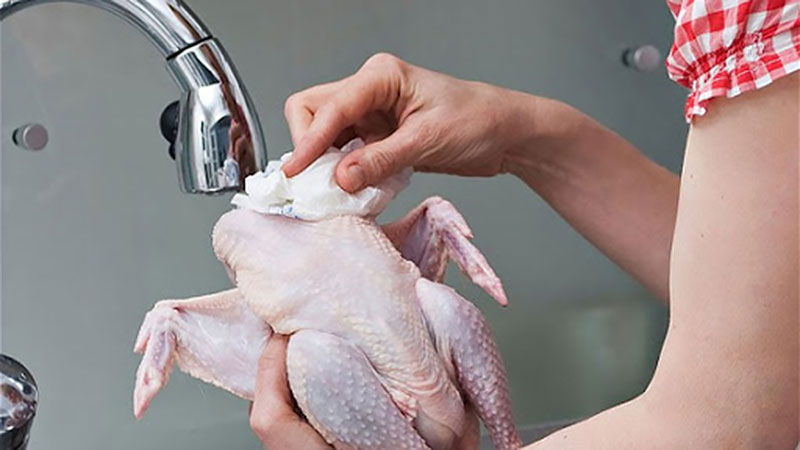Ingredients for Salt-Steamed Chicken
Whole chicken (about 1.5 kg)
500g salt
Lemongrass, chili, shallots, kaffir lime leaves, garlic, ginger, and Vietnamese coriander
Seasonings: Sugar, seasoning powder, fish sauce, ground pepper, and MSG

How to Choose a Good Farm-Raised Chicken
For a delicious farm-raised chicken, look for one with light yellow, thin, and supple skin with good elasticity. The skin should be darker yellow in some areas like the breast, wings, and back. Farm-raised chickens usually have a small, compact body and firm meat.
Fresh chicken meat should not have any unpleasant odors. The skin should be free of bruises or blood pooling. Avoid choosing chickens with dark, dull skin as these are likely to have been dead before processing.
Press your finger into the chicken’s body, chest, or thigh to test for firmness. If the meat is firm and bounces back, it’s a good sign. However, if the meat feels soft, slippery, or deformed, or if there are dents that indicate fluid retention, it’s best to avoid buying such chickens as they may have been injected with water or even harmful substances.
Choosing a Live Chicken
For a Rooster
Look for a rooster with bright red comb and lively eyes. The feathers should be glossy and close to the body. The beak should be sharp and free from any mucus. The legs should be straight and thin, with bright yellow and shiny skin. The spurs should be short, indicating a younger bird. Capon, or castrated rooster, is also a good choice as they are said to have more meat, less fat, and tender bones.
For a Hen
Choose a hen with a bright red comb, yellow legs, glossy feathers, and small pores. Gently press the breast area; if it feels full and the bones underneath are soft, it’s a young hen. Avoid older hens with hard, scaly legs, ruffled feathers, large pores, small necks, and pale, grayish, or wrinkled skin. These hens have likely laid many eggs and may not have the best meat quality.
Additionally, check the hen’s vent. It should be pink and contract well, with no signs of moisture, discharge, or abnormal droppings. Also, look under the wings for small red dots, which indicate water injection. A healthy hen should not have these dots.
Guide to Making Salt-Steamed Chicken with Lemongrass

Preparing the Chicken
To save time, you can buy a whole chicken that has already been cleaned and prepared. Give it a good rinse, both inside and out, to ensure it’s clean.
To reduce any gamey odor, rub the chicken with salt and then rinse it thoroughly with clean water several times to remove the slime. Finally, rinse and pat it dry.
Tip: Besides using salt, you can also rub and soak the chicken in a mixture of salt, vinegar, or lemon juice for 3-5 minutes to eliminate any unpleasant odors.

Preparing the Other Ingredients
Cut off the roots of the lemongrass and wash them thoroughly. Cut two stalks into short pieces, about a finger length, and bruise them. Finely chop the remaining two stalks.
Peel and chop two shallots, and slice the other two. Scrape the skin off the ginger and cut it into thin strips. Remove the stems of the chilies, wash them, and chop one while slicing the other.
Pick over the Vietnamese coriander, discarding any wilted or old leaves, and rinse the rest. Take five kaffir lime leaves and cut them into thin strips. Squeeze the juice from one lime and cut the remaining lime into thin strips.
Marinating the Chicken
Once the chicken is dry, marinate it with 1/2 tablespoon of sugar, 1 teaspoon of ground pepper, 1/2 tablespoon each of seasoning powder and fish sauce, and the chopped shallots, chilies, and lemongrass. Mix well to ensure the chicken is evenly coated.
Make a few slashes on the chicken and rub the marinade into these cuts. Let the chicken sit for about 30 minutes to absorb the flavors.
Steaming the Chicken
First, put about 400g of salt in a pan and heat it for 6-7 minutes. Place the lemongrass on top of the salt.
Then, put the chicken in the pan, along with the Vietnamese coriander, sliced shallots, chilies, ginger, and lime strips. Steam the chicken for about 30 minutes over medium heat.
Making the Dipping Sauce
In a mortar, combine 1/2 tablespoon of salt, 1/2 teaspoon of MSG, 1 tablespoon each of sugar and ground pepper, chopped chilies, and kaffir lime leaves. Lightly pound the ingredients to mix them well, and then add the lime juice and stir again.
The Final Product
The steamed chicken will be hot and inviting, with golden-brown skin. Serve it with the dipping sauce you’ve just prepared.
The salt-steamed chicken is not only fragrant but also tender and juicy. The combination of the salty, spicy, and tangy flavors is simply irresistible. For the best experience, don’t chop the chicken; instead, tear it with your hands to truly appreciate the softness of the meat.
The Ancient’s Advice: In July, the Month of Wandering Spirits, Carry These 7 Items to Ward Off Bad Luck
In many cultures, the 7th month of the lunar calendar is considered an unlucky period. It is believed that during this time, negative energies are more prevalent, and one may encounter misfortune. To counter this, people often carry protective amulets or talismans when they leave the house, believing that these objects will ward off bad luck and keep them safe.






































